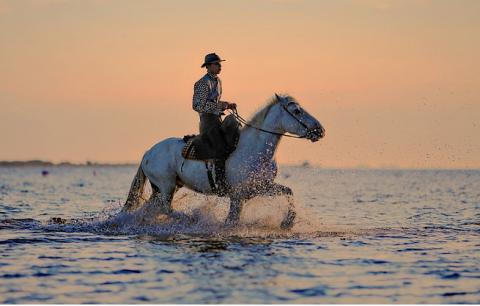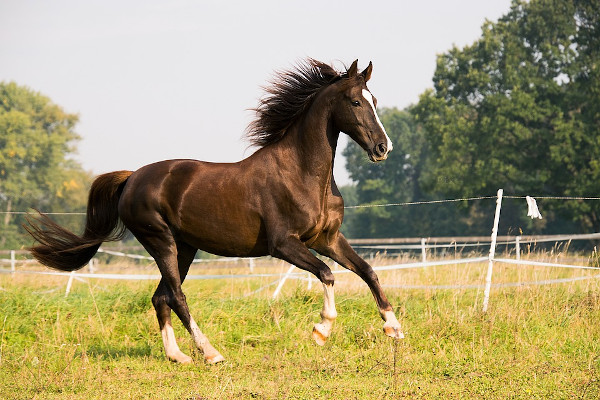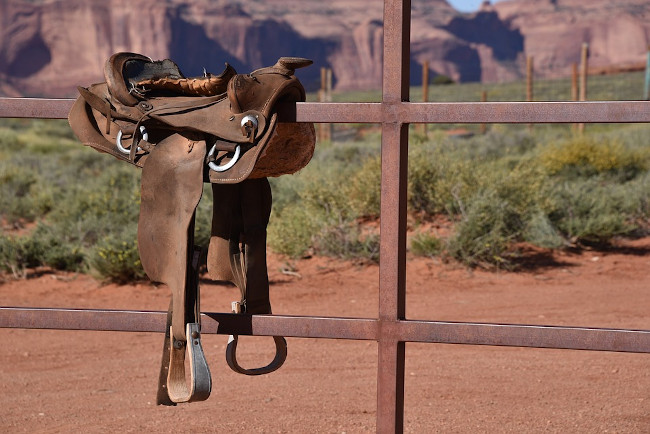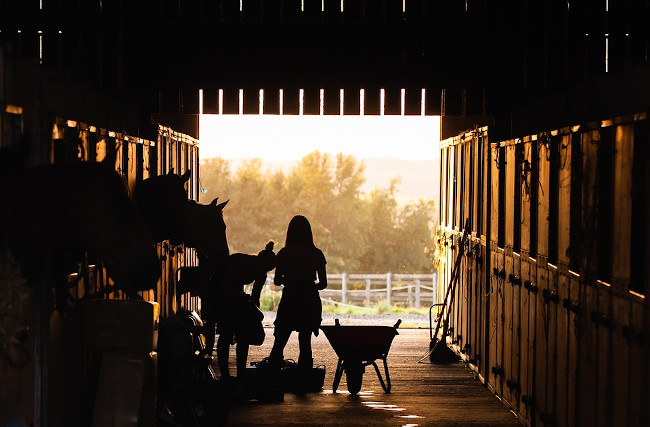Blue Ribbon, Bloody Spurs: Don’t Harm the Horses

With a piece of metal, I gouged her. Jumping off the big ol’ red dog, my silver spurs were tainted with hot blood, chunks of skin, and fuzzy brown fur. My legs broke through a layer of hair, and a veil of skin and blood was drawn. The power and force of my body inflicted sufferable pain that gave me roses, a trophy, and her bloody scars carved in the side of her belly.
I was the token horse guy. I did all the things that people found freakish and deemed genuinely odd. I pretended with my barn mates: Victoria, Maddie, and Kristy to be the four-legged creatures. We imagined a different world where we were untamed, freely galloping alongside one another, snorting like an angered stallion, and leaping over fences. We even went so far as to put the metal gear between our teeth, simulating what it would feel like to be a horse. My love for horses was infinite and borderline obsessive.
When I wasn’t escaping my world or pretending I was one of them, my precious time was spent with my favorite equine, Ty. He was short and white as a cloud with tiny brown specks all over his gray and fuzzy canvas. His eyes were filled with love, and had energy. He was sweet, creating a spot to nuzzle my way in. Ty was 29. Equine publication HorseyHooves describes the lifespan of equines to be 25-30 years, so Ty was a strong old guy and lived a long life. He taught me how to ride, how to steer, and to be daring.
There was Sapphire, a bright orange mare, with a small star in the center of her face and a sweet soft touch for teaching kids how to ride. From learning how to trot to canter, she guided me through years of hot summer training and dangerous competitions with other mindless novice riders -- she was the caring old girl. She was the first horse from which I fell off.
2006 was the first time I had swung my leg over the horse's back, and after years of constantly being at the farm, I grew up imagining an alternative world. In this place, there’s no sadness and no worry, no pain or guilt. I felt like I was more at one with the horses than anyone at school or my family.
Horses talk to one another; they gossip, complain, feel pain, and can form deep soulful bonds. They have siblings, friends, and even lovers. This universe –which we are utterly unaware of -- drove me into creativity, to feel like I belonged.
Every summer and when school was in session, I was the horse’s friend, their family, and I would tell them my deepest, darkest demons. They provided love, safety, and relief. I would work for my horse trainer, Amanda, and at 16, I was one of the go-to men.
We were working toward our annual national competition, where hundreds of equestrians compete in reining, jumping, western pleasure, and fancier riding styles. Hours of preparation and work prepared us to take my trainer's 2008 Ford 150 six-horse attachment truck and trailer and drive it halfway across the country to Oklahoma City.
Over three days, we took the journey with equines, Zeus, Lockland, Knight, Lexy, Raya, Abbie, and Sara. Passing through Arizona, New Mexico, Nevada, and Texas, we pulled into the Oklahoma City fairgrounds at 3:32 a.m. as our beaming headlights glared onto a sign that read, “WELCOME, ARABIAN YOUTH NATIONALS.” We continuously pulled the truck over to hold buckets of water up to the windows, so the horses wouldn’t get dehydrated and found pit stops, so the horses had stalls for the night.
I was exhausted. We unhitched the trailer door, and the foulest, seeping smell emulated from the trailer. We took the horses out and put them in their designated metal stalls. Feeling drained, we headed to our quaint cottage Airbnb, south of the fairgrounds.

One of the four massive barn lights shines on the 12 x 12 metal stalls and flickers repetitively. My barely lit iPhone reads 4:34 a.m., and I felt a change in energy. Looking into the brown eyes of the red horse, Zeus, their eyes look black and almost lifeless. The deep neigh of the gray horse, Sara, rattled the cold metal, and the struggling light felt dull. Something was missing within these ghost town barn aisles. The buzz of the light doesn’t feel warm like the connection between an animal and their human.
I opened my crusty eyelids and rolled over on my wired mattress in Oklahoma City. I tried to pull away from my quicksand white sheet bed because I had slept for only an hour and a half. I mustered up the courage to get off the bed and into my dirty tee, wrangler jeans, two jackets, and my cowboy boots that tore from both sides of the sole.
Arriving early at the competition, the hot Midwest orange star set low as sunlight crept through the pines and emulated a glow on the fur. The touch of softness, the profoundly soulful and heart-wrenching connection a horse gives, is therapeutic. Yet all of our show horses looked tired, saddened.
It's the first day of the competition. Amanda, now more my boss than trainer or friend, stutters at me.
“Walker, go get Lockland -- go lunge, and get him ready for Jessica’s class at 9 a.m.”
I did as I was told. I walked down the aisles and reached the red and brown horse. I walked into his stall to see him standing like a stone statue, cold and lifeless. I rubbed his shoulders, letting him know I was there, and I moved my hands to his face. Wrapping the leather Shell Cordovan halter around his broad nose, I look into his black eyes.
After exercising the horse, I brought him into the crosstie, which is two chains that attach to the horse's halter in the middle, keeping them stationary when getting them ready or tacked up to ride. I started to get him ready for the show. I buckled the metal hooks to his leather halter and grabbed the brushes to de-dirt and de-matte the ‘bed head’ of the fur. I grabbed a brush, and with circular motions, I started decluttering. With hard force, I scrubbed the manure, pee, and mud out of the fur. I grabbed a hairbrush and combed through the detangled jungle of a mane. I then looked for the hoof pick. A hoof pick is a tool that almost resembles a hammer. It has a handle and a hook at the end that you use to clean dirt out of the horse's hoof -- think of this process as almost like cuticle care. When I deemed Lockland to look somewhat cleaner, it was time to put the “tack” or suit on.
I walked into the leather-filled room of saddles and bridles for an equestrian, and the tack room was like a big warm Christmas morning. I grabbed the martingale, a device that loosely wraps around the base of the neck that connects underneath to the horse’s gear and provides questionable leverage when riding them. I reached for the black saddle pad and walked to the $21,000 Dover saddle. As my pokey spears jingled as I walked, I gathered all the tack and returned to the big ol’ red dog to suit him up.
I threw the black saddle pad over his back and laid it flat. I grabbed the 50-lb western saddle and hoisted it up and over, placing it gently on his back and adjusting the saddle, so it didn’t weigh incorrectly on his spine. I then grabbed the girth -- think of the girth as a belt. It's a short piece of leather that’s long and can adjust to a horse's belly. A belt keeps your pants up from falling or fitting ill, and the girth does the same. It needs to be centralized and tight to maintain the saddle in the correct position; however, horses don’t like it.

If the girth is in the wrong position, it triggers the horse. Bull riders and bronco riders use a strap that goes under the back half of the horse or bull that causes them to thoroughly buck and explode because that strap is hitting an uncomfortable or painful spot. According to the equine publication Riding Hall, bronco riders have a piece of “leather cinched with a pad around the horses’ girth.”
Attaching the girth to the saddle and wrapping it under the belly of the horse to the other side, I cinch the leather belt as tight as I can, gutting him. Lockland pins his ears in discomfort, eyes flared and biting air. I saw him in discomfort and pain, but I continued cinching and latching all the leathers to be intact. The last step is putting on the bridle to complete the tacking-up process. A bridle is a combination of different leathers that go across the face, under the throat, and around the ears and are ultimately used to have control of the horse. The worst part of a bridle is the bit.
Bits have various forms of power, but they’re metal attachments that go through the horse's mouth that give you access to the reins. It allows the horse to follow specific cues you tell them through the leathers you hold, the reins attached to the bit in their mouth. A left tug means to go left, a right jerk means to go right, pulling back with both hands means to stop, and the release or no pressure is the cue to move forward. Holding the bit in place, trainers usually use a flash. A flash is a leather strap that restricts the horse from opening its mouth and can cause severe pain and discomfort, depending on how powerful the bit is.
The bits, the gear and the cold, lifeless horses caused a stream of emotions suddenly washing over me with the gut-wrenching feeling of no longer living with zero sadness, no worry, and no pain or guilt. I felt guilty and sad. The pain inflicted by me and others seemed to be the “norm” in this industry, but to what extent?
Some consequences of riding horses can be questioned. Some of the equipment, like bits, martingales, spurs, whips, and flashes, can inflict pain on horses. For instance, the Arabian Horse Industry has horses trained in the unnatural neck and head positions. With a difference in harshness in the metal bits within the horse’s mouth, the Rolkar work -- a “practice of hyperflexion of horse’s neck,” becomes more apparent in restricting the horse's neck position to not “raise above the bit.”
This term Rollkur is usually associated with dressage, which is almost like a dance between two people -- a deep connection and working faultlessly together. Yet, no matter the discipline, if this hyper-flexion is trained, it can be challenging for the horse to continue performing at the high bar humans make them jump.
The Arabian Horse Association and the Morgan Show Industry are highly competitive with expensive hunter horses, western pleasure, driving horses, and countless other styles of horses. Some techniques, like ranch pleasure, are less intense in this flexed next position. However, hyper-flexion is more common in more intense show horses. In Practical Horseman, quotes from study to study provide evidence that “a resounding 88 percent of the studies reported that hyperflexion adversely affected the horse.”
Memories flooded my brain of my old horse that looked like Ty -- his name was Sky. He lived in California; he was loving, gentle, stubborn, and didn't know my personal space. His fuzzy nuzzle a normal and comfortable feeling, but I trained him with all this harsh equipment until the end of the competition season -- he injured himself while I was competing.
We took Sky back to the farm to let him rest and be examined by a vet. He got a lameness exam, which determines what hurts the horse and in what area. Lameness is a hitch or abnormality within the horse's gait that can be tested through flexibility tests, hoof tests, and a joint exam that tests sensitivity. The vet examined Sky.
“It’s not too bad; we could block him.” the vet said.

Blocking him would let me compete with Sky at the 2019 national competition. A dream come true, a fulfillment that would make me feel complete, but blocking comes with complications.
Blocking injects a nerve-numbing drug in the horse's specific area of pain, taking the discomfort or serious injury away, which you can assume only prolongs and damages the injury. According to EquiSearch, blocking is using lidocaine or carbocyanine, and “the veterinarian anesthetizes (numbs) these nerves at a certain location, everything on the leg below that location will cease to feel stimuli- including pain.”
I snapped back into work mode as my 30-minute reminder that my competition started at 7 p.m.
I got ready. I was showing a horse named Raya, a 6-year-old, sweet, red puppy dog. I pulled on my tight white-collared shirt, slipped into my tan, skintight breeches, put on my navy tailored dress coat, and with a thin, black piece of fabric tied the trio of numbers ‘345’ in the middle of my back, which identifies who I am.
My nerves were sweating as it was time to start. As I trotted into the arena with the judges’ and crowds' eyes on me, I moved along through two different brackets. Competitions are like tournaments; you make one cut and move on to the next. Raya and I went through two different brackets and won each one. We made it to the final. My form was tight, my mind was focused, and Raya and I nailed it.
We were in sync, gliding across the soft brown dirt as one. We beat 50 horses, won second best, and earned a national championship title. I had hot, streaming tears down my face as the numbers “3-4-5” blared out of the auditorium speakers, giving me a national title and putting a blanket of tricolored roses: yellow, red, and white across Raya’s shoulders. They put the 6-ft long blue ribbons on her bridle and my jacket.
My mother, Shannan, and my sister, Madison, both cried as they ran into the area to celebrate my win with the traditional victory winner’s photo. In my mind, I had done it -- I had won. All the anxiety of not feeling good enough, the broken spirit, and the tears were all for this moment. I made it.
As one of the nation's top dogs of my age division, I enthusiastically jumped off Raya. I hit the dirt, blue water-filled eyes became level with her belly. Spots of rubbed fur and struggling-to-heal skin covered her lower abdomen. I remembered that I had cut Raya with my metal spur when training.
In our last training session, I left the practice area and looked down at something clunky and red mixed in with the gravel. I bent down to see blood. Thinking it was mine, I then saw Raya’s belly. Gashed, ripped, and bloody, her skin was flapping and holding on by hairs. Her fur was ripped off, and her bare pink skin was raw and exposed to dirt, bacteria, and infection.
I looked at the back of my boot, and my shiny, silver spurs were no longer metallic but somewhat shiny with the blood of an animal. I hurt her. I inflicted pain on her; she couldn't say anything if she moved out of place. I corrected her with my legs and body. She was telling me something, and I caused more pain in her, and for what? My pleasure? Or worse, a ribbon?
My eyes stared at the bare skin scars. My win suddenly didn’t feel like a victory anymore.

There are altering beliefs of whether riding horses and competing with them is abusive and inhumane. Competitions drive until perfection is met, and many in the equestrian industry think it’s worth turning a blind eye, so they can continue doing what they like. The form of abuse, the metal bits in the mouth, spurs, girths, whips, blocking, the flash, and the harshness we inflict on the horses for our gain fits in the questionable behavior. We use devices like the martingale, spurs, or whips that benefit us to get money, ribbons, and trophies while giving the horses arthritis, scars, trauma.
Horses can’t speak; they can't tell you what hurts, and they can’t scream. They can only show discomfort and a lack of enjoyment. As a lifelong equestrian, you’re ignorant when turning aside, and I was ignorant. At that moment, I lost touch with that fantasy world. There was no pain, sadness, or guilt because the horses felt the pain, and I felt the guilt. I was drowning in my guilty conscience about publicly abusing an animal, and what’s authentic or empathetic about being ignorant of the health and well-being of the animal you supposedly love? Nothing.
Whether it was using harsher gear on Sky or cutting Raya, it hurt me knowing that I was a part of the problem, not the solution. I came home with blood-tainted and guilty roses. I focused on emulating that magic that once filled my upbringing with horses and advocating for solutions. I took off the spurs, took the bit out of their mouth and the saddle of their backs. I worked from the bottom back to the top, fixing what I had broken. I worked endlessly with Sky.
I returned to the farm as a winner, but my heart needed to re-teach the deep connection I had with Sky, and while continuing to ride, I was finding a balance. A balance between riding horses and enjoying that therapeutic feeling without the constraint or blockage of trust that tack and gear can cause.
When you train with the tack, grow up with it, and are comfortable with training the animals that way, it becomes hard to continue riding the horses you love while relearning the pre-exposed knowledge or misuse of the equipment to the correct way of using and training horses.
The horses felt cold and lifeless when we were competing, but after I removed the energy blockage, the liveliness came back into Sky's eyes. He no longer looked like Lockland, a lifeless statue. He had energy, drive, and a willingness to connect with me.
Banning competitions that involve animals for human benefit and profit won’t happen.
One way of re-teaching less intense ways of riding horses is using a bitless bridle. A bridle without the metal bit in the mouth that isn’t tugging or treating nerve pain. Bitless riding isn’t a new concept. According to Horse Illustrated, bitless, tackless riding has been more popular with owners of horses who own for pleasure – as opposed to those who own horses for competition or money.
Bitless and Beautiful, a nonprofit organization, aims to bring back more humane types of horsemanship.
With any relationship, communication is essential to promoting a clear understanding of trust and direction, wants, or needs. With a possible block, the clear message can become blurry, and the misuse, especially the misuse of bits, can restrain the connection from growing.
I had to unlearn what I learned in childhood. Instead of using the metal spurs I grew up using, I dealt with the leg pain that results. I tried to use bitless bridles when riding and tried to ride without a saddle as much as possible.

This challenging, confusing, and expensive sport saved my life in a dark, dark place. Instead of wanting to ride because I loved it, as a teenager I also wanted money, trophies, ribbons, an enormous ego, or applause. With those themes, I overlooked the state of wellness of the horses, to a degree.
Now, realizing some of the ways we train horses or ride them is unethical, I choose to partner with equines because it’s my therapy.
Under the warm, yellow California sun, I’m living the dream that once filled my love for horses. The grass grew tall and we were galloping alongside one another in the rolling green hills -- free of restriction, fear, and pain. I don’t want to hurt my companion; he is my rock, my partner, my true friend.
Author Bio:
Walker Hardy is a contributing writer at Highbrow Magazine.
For Highbrow Magazine
Image Sources:
--Photo-graphe (Pixabay, Creative Commons)
--Rebecca’s pictures (Pixabay, Creative Commons)
--Huskyherz (Pixabay, Creative Commons)
--Algorino (Pixabay, Creative Commons)
--TechPhotogal (Pixabay, Creative Commons)
--TheOtherKev (Pixabay, Creative Commons)

































































































































































































































































































































